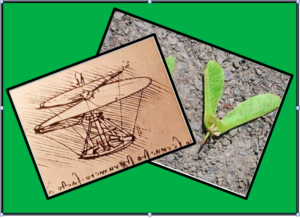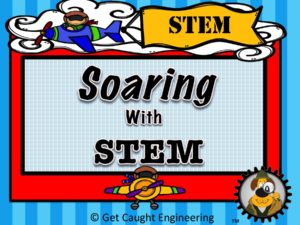On December 17th, 1903, two gentlemen, who were not professional scientists or engineers, first flew their invention that would change the world. Wilbur and Orville Wright flew their plane for only a short distance that day but they started an extraordinary journey for mankind. If you want your students to understand perseverance, curiosity, and determination, make room in your lesson plans to study flight and to celebrate the lives of the Wright Brothers. They exemplify all that is important about STEM and provide a wonderful foundation for a theme that explores the principles of flight. Humans have always been fascinated by flight. Since the beginning of time, people have looked up at the sky, watched birds and dreamed of spreading their own arms and taking flight. Leonardo d Vinci through his study of the structure of birds, sketched designs of a flying machine. This fascination continues today. Watching planes take off at an airport conjures up visions of exotic faraway places, excitement and freedom. As common place as hopping on a plane to get somewhere is to everyone, most people don’t understand why birds and planes can fly. Discussing and experimenting with the basics of flight have always been some of the most popular STEM activities among students. However, the principals of flight is not part of any elementary or middle school curriculum. Yet, with a little creativity, these lessons can be integrated into a variety of topics. Animal Adaptations The study of how animals adapt to their environment is a focus of study across different science units. This is a perfect opportunity to compare the shape of various birds’ wings and relate them to the different types of jets and planes and their corresponding wing shapes. Different birds have different wing shapes depending if they primarily glide through the air, if they have a need to take-off quickly to escape from predators or if they need to have time to get a running start. Scientists have studied these wing shapes and use these same wing shapes. Our gliders copy the wings of birds that glide and planes that need a quick take off copy the wings of robin. NASA has a wonderful series of lessons that can help your students explore this aspect of animal adaptation and how humans have copied it NASA - Wing Design Weather Air pressure is one of the topics during the study of weather. A typical activity is to have students blow across a single piece of paper. The paper rises because of the difference of air pressure above and below the paper. A logical next step is to relate this phenomena to flight and a discussion of the basic concepts of lift and drag. The difference in density of warm and cold air masses and how they affect our weather can be a difficult topic for students to understand. One way to illustrate how warm air rises is to have students fashion an air balloon. Using a hair dryer, students will inflate the air balloon to get it to rise. Plant Adaptations Just as animals have a variety of adaptations to help them survive plants do too. Odd as it sounds, a variety of plants reproduce through the use of seed pods that rotate through the air just like a helicopter rotors do. There are lessons available to show students how to fold a piece of paper so that it will rotate like the seed pod – and a helicopter rotor. While exploring flight, be sure to include an exploration of helicopters. There are lessons available to show students how to fold a piece of paper so that it will rotate like a helicopter rotor. Toss it into the air and watch how it rotates as it falls back to the ground. During the study of plants and seed dispersal, bring in examples of the pods. STEM and Soaring with Helicopters Flight and Literature Integrating STEM into literature is one of our favorite ways to integrate STEM into other curriculum. Students can learn the basics of how to write a research paper while learning about the history of flight. Every program of studies include biography units. Designing, building and improving on airplanes is a logical extension while studying the lives of Leonardo di Vinci, the Wright Brothers or other titans of flight. Wright Brothers Information National Park Service : Wright Brothers Air and Space Museum - Wright Brothers Museum of Science - DaVinci Engineering Day Another way to integrate flight into the curriculum is to have an Airplane Challenge as part of an Engineering Day or STEM night. Students will love to create airplanes and improve upon their designs as they try to have their plane fly further than their classmate. Check out our Great Paper Airplane Challenge. It has everything you need, including categories and certificates for winners, to run a successful Paper Airplane Challenge. The Great Paper Airplane Challenge Resources There are a lot of great resources available to help you integrate flight into your curriculum. The Smithsonian Museum has developed a series of lessons called “How Things Fly” and have a series of lessons to teach the basic principals of flight. How Things Fly Another good source is Science Kids that has lessons on flight aimed at elementary students. We also have a bundle of different types of STEM challenges concerning flight. A Bundle of Aeronautical Engineering Year after year, lessons that incorporate flight and give students the opportunity to create planes, helicopters, gliders and parachutes continue to be our students favorite lessons. More than just fun however, it gives the students opportunities to experiment with sometimes hard to imagine science basics. By combining a study of the history of flight with hands on STEM activities, you will engage your students in a wonderful learning experience.
We hope you "Get Caught Engineering"!
Wendy and Cheryl
* This was originally a guest blog that we posted in November 2015 on the "Virginia is for Teachers" site.*What They Say

Wendy came to Bellevue Arts Museum to co-lead our Full STEAM Ahead! Summer Camp in August 2014. This camp was a huge success thanks to her expertise, experience, and warmth working with the campers throughout the week…
MEGAN DYE
Educational Outreach Director, The Bellevue Art Museum, Bellevue, Washington













